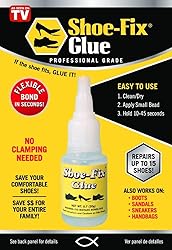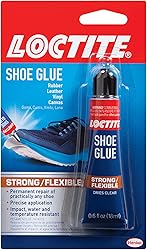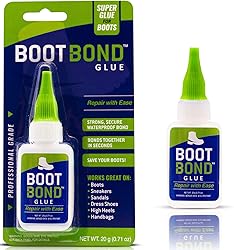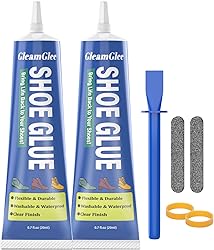Whether you’re reattaching a sneaker sole that’s seen one too many hikes or gluing the heel back on your favorite dress shoes, having the best glue for shoes on hand can be a real game-changer. I’ve spent enough time fixing my own kicks to know that not all adhesives are created equal. Some dry too brittle, others don’t hold for long, and a few just turn into a sticky mess. The good news is, I’ve tested a bunch of them so you don’t have to.
In this roundup, I’m sharing the glues that actually held up when it counted. I looked at how well they bond rubber, leather, fabric, and synthetic materials and how they handle wear and tear over time. Whether you’re a weekend DIYer or someone who just wants their shoes to survive another season, you’ll find options here that get the job done without the hype. Let’s take a closer look at what works—and what’s worth skipping.
Best Glues For Shoes in 2025
| Image | Model | |
|---|---|---|
 | Best For All-Purpose Shoe Repairs Shoe Goo ClearEditor's Choice  Check Price | Check Price |
 | Best Fast-Drying Option For Everyday Repairs Shoe-Fix GlueCheck Price | Check Price |
 | Best Glue For Flexible Shoe Materials Loctite Shoe GlueCheck Price | Check Price |
 | Best Fast-Setting Shoe Glue ALECPEA Shoe GlueCheck Price | Check Price |
 | Best for Quick Boot Repairs Boot Bond GlueCheck Price | Check Price |
 | Best Clear-Drying Glue For A Seamless Finish Angelus CementCheck Price | Check Price |
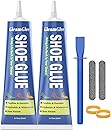 | Best for Precision Shoe Repairs Pro Grade Shoe GlueCheck Price | Check Price |
1. Sof Sole Shoe Goo Clear Adhesive
If you’ve got a shoe on life support, Shoe Goo is basically your emergency room in a tube. I’ve used this glue on everything from flapping soles to splitting seams, and it hasn’t let me down yet. It’s got that perfect balance of stickiness and staying power—you get a good, flexible hold that doesn’t crack or peel once it sets.
The application takes a bit of care—it’s thick, and it likes to flow wherever gravity tells it to. But once you get it in the right spots and let it sit tight for a day (or more, if you’re patient), it’s like hitting the reset button on your footwear. It dries clear, so if you’re tidy with your work, no one even has to know your shoes were on the verge of retirement.
I’ve patched holes in canvas, re-attached rubber soles, and even reinforced worn-down heels. Bonus points for being waterproof too—I’ve had repairs last through rain and mud. It’s not a miracle glue—it takes time to cure and it smells like a chemistry lab—but it absolutely gets the job done when done right.
Pros:
- Forms a durable, flexible bond on most shoe materials
- Dries clear and cures to a waterproof finish
- Plenty in the tube for multiple fixes
- Versatile enough for other DIY uses beyond shoes
Cons:
- Full cure takes up to 24 hours or more
- Can be messy if not handled carefully
2. Shoe-Fix Glue Professional Grade
Every now and then, I come across a glue that feels like it was made by someone who actually knows what it’s like to walk a mile in busted shoes. That’s how Shoe-Fix Glue strikes me. It’s not just quick — it’s lightning fast. This stuff bonds in seconds, which means you’ve got to get your pieces aligned right the first time. But when it sets, man, it *sets*. Soles, edges, straps — all back in working order without the usual wait or clamping game.
I tried it out on a beloved pair of walking shoes with a peeling sole, and within a couple minutes, it looked and felt like nothing had ever come loose. The clear finish dries neat — no gummy mess, no discoloration — and it stays flexible, which is a big deal for shoes that move with you. I wouldn’t lean on it for big structural rebuilds or heavy-duty boots that take a real beating, but for standard wear and tear? Absolutely. And it’s earned a spot in my tool drawer for plenty of non-shoe fixes too.
Pros:
- Incredibly fast bonding — no clamping needed
- Dries clear and flexible — clean finish
- Works on a variety of materials, even beyond footwear
- Compact tube with precise, no-mess application
Cons:
- May not hold up for heavy-duty or high-stress repairs
- Sets so fast there’s little room for error during application
3. Loctite Shoe Glue Strong & Flexible
When you work on shoes that have to flex and move with every step—from sneakers to canvas slip-ons—you need glue that won’t crack under pressure. Loctite Shoe Glue really pulls its weight in this area. I’ve used it for rubber soles separating from leather uppers and even patched up some torn canvas. It handles that job with surprising confidence.
The best part? It dries flexible and invisible. You’re not left with that amber glue line a mile wide. Set time is fast enough that you’re not stuck there holding pieces together for ages, but it gives enough time to reposition if you miss your mark. It’s also built for real-life wear—rain, rough streets, and even the occasional run-in with a dog who thinks your shoe is a chew toy. This stuff stays stuck.
Pros:
- Dries clear and stays flexible
- Handles water, vibration, and extreme temps
- Strong bond on a wide range of materials
- Good for small gaps and repairs
Cons:
- Small bottle doesn’t go far on big repairs
- Nozzle requires careful cleaning or it’ll clog
4. Alecpea Shoe Glue Ultimate Strength
If you’ve ever had a shoe come apart when you’re out the door and already late—well, I’ve been there. That’s why I keep a tube of Alecpea Shoe Glue on hand. This stuff sets faster than a New York minute, which makes it perfect for quick repairs. It saved a pair of my son’s beat-up work boots that had the sole almost dangling off—got it patched up in no time, and it’s been holding strong for over half a year.
What impressed me most was the combination of strength and precision. It has that gel-like texture that doesn’t run wild on you, and the included micro-nozzles make application a breeze—even for tiny fixes on rubber, silicone, or tight-fit seams. I used it to reattach a sneaker sole that was flapping like a loose license plate, and 24 hours later, it felt like it was molded that way from the factory. Just be quick and careful—it dries fast and bonds strong. Definitely wear gloves unless you want your fingers to become a permanent part of your shoe.
Pros:
- Sets in seconds and cures quickly
- Strong, flexible bond great for various shoe materials
- Includes precision nozzles for controlled application
- Handles weather and rough conditions with no problem
Cons:
- Thicker gel consistency can get messy if you rush
- Nozzles are single-use, so plan accordingly
5. Boot Bond Quick-Dry Shoe Glue
When you’re staring down the flapping sole of your favorite hiking boots (again), Boot Bond’s quick-dry formula is the kind of no-fuss fix that spares you a trip to the cobbler—or the guilt of tossing a perfectly good pair. It sets up fast, in something like half a minute, which makes it real handy when you’re in the middle of a multitask marathon and just want your gear functional again.
The tip design gave me solid control without turning my fingertips into a sticky mess, and I appreciate that it stays slightly flexible after drying. That’s a must when you’re walking all day or putting pressure on the joint. I’ve used it on everything from rubber soles to leather, and even patched up a belt buckle once when I was in a pinch. It doesn’t require any fancy clamping rig—just pressure and time. Though if you’re fixing something under tension, an overnight clamp still pays off.
Pros:
- Dries quickly — ready to hold in 30 seconds
- Stays flexible, great for moving parts like soles
- Precision tip makes application easy and clean
- Multi-use — worked well on different materials
Cons:
- Some repairs may not last long on high-stress spots
- Small bottle — easy to go through it quickly
6. Angelus Clear Shoe Cement
I’ve worked with my fair share of adhesives over the years, and I have to say, Angelus Clear Shoe Cement feels like it was made by someone who actually repairs shoes for a living. What I like most about it is how clean and neat the finish is. Once it’s dry, you’d be hard-pressed to tell there was ever a repair — no globs, no yellowing, just a seamless fix that holds its own. That clear bond is a blessing when you’re working on expensive sneakers or leather boots and want to keep them looking sharp.
Now, it does require a bit of attention when applying. This isn’t a slap-it-on kind of glue — timing is key. You’ll need to apply the cement and join your surfaces quickly, because it tacks up fast and doesn’t behave like a traditional contact cement. But once you get the method down — brush, clamp, wait — this stuff sets up strong and flexible. I’ve had repairs on my work boots holding strong after months of abuse, and I even used it in a side-by-side test with another well-known brand. Angelus held its ground just fine.
It’s not totally bulletproof — if you don’t follow the instructions precisely, especially when it comes to clamp time, the bond might disappoint. But if you’re willing to spend an extra minute reading the label (you really should!), this glue delivers a solid seal every time.
Pros:
- Dries clear – looks clean even on visible repairs
- Forms a strong, flexible bond with leather, rubber, and more
- Quick setting time speeds up the repair process
- Built-in brush makes application easy and precise
Cons:
- Requires precise timing during application or bond may fail
- Can dry out if not sealed properly after opening
7. Professional Grade Flexible Shoe Glue
Let me tell you, this glue has a lot going for it—and I’ve seen my fair share of shoe glue over the years. I tried it on an old pair of canvas sneakers that had lost their sole—not just metaphorically—and came away pretty impressed. The stuff goes on smooth and clear thanks to the fine metal tip, which really helps when you’re working on small cracks or seams. It’s got good tack right out of the tube and stays flexible once cured, which is key for anything that’s going to bend and move on your feet.
It even held up after a dunk in a puddle, which earns it some serious points in the durability department. I wouldn’t use it for completely rebuilding a sole—tried that, didn’t stick 100% after a hard walk—but it’s gold for touch-ups, sealing edges, and keeping minor wear from turning into major repairs. And the kit comes with sandpaper, a spreader, and rubber bands, so you’re set to go straight out of the box. For little fixes that need finesse, this one gets my stamp of approval.
Pros:
- Precise applicator makes detailed work easy
- Dries clear and stays flexible
- Waterproof bond holds up to moisture
- Comes as a full repair kit – ready to use
Cons:
- Not ideal for full sole replacements or high-stress repairs
- Needs prep and curing time — not a quick fix solution
What to Look for When Buying Shoe Glue
Material Compatibility
Trust me, I’ve learned this the hard way after trying to fix my work boots with whatever adhesive was lying around the garage. Not all glues work on all shoe materials — leather needs different treatment than rubber, and synthetic materials are their own beast entirely. Leather shoes respond best to flexible adhesives that won’t crack when the material bends, while rubber soles need something that can handle constant flexing and ground contact.
Canvas sneakers are probably the most forgiving, but even then you want something that won’t stiffen the fabric or show through. I once used super glue on a canvas shoe (don’t ask how I know) and ended up with a rigid patch that felt like walking on cardboard. Synthetic materials like vinyl or faux leather often need specialized formulas because regular adhesives just won’t bond properly.
Flexibility After Curing
Here’s something most people don’t think about until it’s too late — shoes bend, twist, and flex with every step. A rigid glue joint will fail faster than you can say “warranty void.” I learned this when I repaired a hiking boot sole with standard epoxy that seemed bulletproof until I took my first step. The bond cracked immediately because it couldn’t handle the natural movement of walking.
Look for adhesives specifically marketed as flexible or designed for footwear repairs. These formulas stay somewhat pliable even after they’re fully cured, allowing the repair to move with the shoe. Polyurethane-based adhesives are usually your best bet here, though they take longer to set than some alternatives.
Water and Weather Resistance
Unless you live in a desert and never step in puddles, your shoe repairs need to handle moisture. Regular white glue or basic craft adhesives will dissolve faster than sugar in rain. Waterproof formulations are worth the extra cost because they’ll actually last through normal wear and weather exposure.
I’ve seen too many “permanent” shoe repairs fail the first time someone walks through morning dew. Temperature extremes matter too — adhesives that work great in room temperature can become brittle in winter cold or soften in summer heat. Look for products that specify temperature ranges if you live somewhere with extreme weather.
Working Time and Cure Speed
Some glues give you about ten seconds to get things positioned right, while others let you work for several minutes. Consider your skill level and the complexity of your repair when choosing cure speed. Fast-setting adhesives are great for simple fixes, but if you’re trying to reattach a sole or do detailed work, you’ll want something that gives you time to get it right.
Don’t confuse initial tack with full cure time either. Many adhesives will hold within minutes but need 24 hours or more to reach full strength. I’ve made the mistake of testing a repair too early and having it fail, only to find out later that I just needed to be more patient.
Types of Shoe Damage and Best Adhesive Matches
Sole Separation
When the sole starts peeling away from the upper, you’re looking at probably the most common shoe repair. This usually happens at the toe or heel first, where flexing is most intense. Contact cement or polyurethane adhesives work best here because they create flexible bonds that can handle the constant stress of walking.
The key is cleaning out all the old adhesive and dirt before applying new glue. I use a wire brush and degreaser to prep the surfaces — sounds like overkill, but adhesion is only as good as your surface preparation. Apply thin, even coats to both surfaces and let them get tacky before pressing together.
Torn Upper Material
Tears in leather, canvas, or synthetic uppers need different approaches depending on the material and location. For leather, you want something that soaks in slightly and creates an invisible repair. Canvas tears often need reinforcement from behind with a patch, while synthetic materials might need specialized plastic adhesives.
Location matters too — tears near high-flex areas like the toe box need more flexible repairs than tears on the side panels. Sometimes a slightly visible but durable repair is better than an invisible one that fails after a week. Been there, learned that lesson the expensive way.
Heel and Toe Protection
Adding protective patches to heels or toes before they wear through is smart preventive maintenance. Use thin, flexible adhesives that won’t create lumps or pressure points inside the shoe. Clear formulations work well here because they’re less visible, especially on lighter-colored shoes.
The trick is roughing up smooth surfaces slightly before gluing — not enough to damage the shoe, but enough to give the adhesive something to grab. Fine sandpaper works, or even a nail file for small areas.
Application Tips That Actually Matter
Surface Preparation
Clean surfaces are everything in adhesive work. Dirt, oils, and old adhesive residue will prevent proper bonding no matter how good your glue is. I use denatured alcohol for most cleaning, but sometimes you need acetone or specialized cleaners for stubborn residues. If you skip this step, you’re basically guaranteed to do the repair again in a few weeks.
Rough up glossy surfaces lightly with fine sandpaper — not enough to damage the material, just enough to give the adhesive some tooth to grab. This is especially important on rubber soles and synthetic materials that often have mold release agents or other surface treatments that interfere with bonding.
Temperature and Humidity
Most adhesives are sensitive to environmental conditions, though manufacturers don’t always make this obvious on the packaging. Cold temperatures slow curing and can make adhesives thick and hard to apply. High humidity can interfere with some formulations, while others actually need a little moisture to cure properly.
I do most shoe repairs in my heated garage where I can control conditions somewhat. Room temperature and moderate humidity work for most adhesives. If you’re working in your basement or an unheated area, bring the shoes and adhesive to room temperature first and consider using a small heater to maintain decent working conditions during the cure time.


